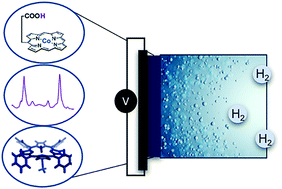当前位置:
X-MOL 学术
›
Catal. Sci. Technol.
›
论文详情
Our official English website, www.x-mol.net, welcomes your feedback! (Note: you will need to create a separate account there.)
Hydrogen evolution by cobalt hangman porphyrins under operating conditions studied by vibrational spectro-electrochemistry†
Catalysis Science & Technology ( IF 5 ) Pub Date : 2018-02-21 00:00:00 , DOI: 10.1039/c7cy02253k Patrycja Kielb 1, 2, 3, 4, 5 , Marius Horch 1, 2, 3, 4 , Pierre Wrzolek 1, 4, 6, 7 , Robert Goetz 4, 8, 9, 10 , Khoa H. Ly 1, 11, 12, 13 , Jacek Kozuch 1, 14, 15, 16 , Matthias Schwalbe 1, 4, 6, 7 , Inez M. Weidinger 4, 8, 9, 10
Catalysis Science & Technology ( IF 5 ) Pub Date : 2018-02-21 00:00:00 , DOI: 10.1039/c7cy02253k Patrycja Kielb 1, 2, 3, 4, 5 , Marius Horch 1, 2, 3, 4 , Pierre Wrzolek 1, 4, 6, 7 , Robert Goetz 4, 8, 9, 10 , Khoa H. Ly 1, 11, 12, 13 , Jacek Kozuch 1, 14, 15, 16 , Matthias Schwalbe 1, 4, 6, 7 , Inez M. Weidinger 4, 8, 9, 10
Affiliation

|
Cobalt hangman complexes are promising catalysts for dihydrogen production, yet their electrocatalytic performance in aqueous environment is still a topic of dispute. Surface-enhanced resonance Raman (SERR) spectro-electrochemistry has a great potential to give insight into the reaction mechanism of such molecular catalysts attached to electrodes under turnover conditions. However, the intrinsic catalytic activity of plasmonic supports and photoinduced side-reactions make the in situ analysis of their structures very challenging. In this work, the structure of hangman complexes attached to electrodes via dip-coating was investigated during catalytic turnover by electrochemistry and SERR spectroscopy. In order to explore the relevance of the hanging group for proton supply, complexes bearing a carboxylic acid and an ester hanging group were compared. For the former, SERR spectra recorded under turnover conditions indicate the reductive formation of a CoIII–H species, followed by laser-induced translocation of a proton to the carboxylic hanging group and the associated formation of the CoI state. Due to the lack of a proton accepting group, hangman complexes with an ester group could not be trapped in the CoI intermediate state and as a consequence SERR spectra solely reflected the (photo-enriched) CoII resting state under turnover conditions. These results represent the first Raman spectroscopic insights into intermediates of dihydrogen evolution catalysed by cobalt hangman complexes on electrodes and support the direct involvement of the hanging group as a proton shuttle.
中文翻译:

通过振动光谱电化学研究在操作条件下钴by子卟啉释放氢†
钴子手配合物是生产二氢的有前途的催化剂,但是它们在水环境中的电催化性能仍然是一个有争议的话题。表面增强共振拉曼光谱(SERR)光谱电化学具有很大的潜力,可以深入了解在周转条件下附着在电极上的此类分子催化剂的反应机理。然而,等离子体载体和光诱导的副反应的固有催化活性使得对其结构的原位分析非常具有挑战性。在这项工作中,子手配合物的结构通过电极连接到电极上。通过电化学和SERR光谱研究了催化转化过程中的浸涂。为了探索悬挂基团与质子供应的相关性,比较了带有羧酸和酯悬挂基团的配合物。对于前者,在更替条件下记录的SERR光谱表明还原形成了Co III -H物种,随后是激光诱导的质子向羧基悬挂基团的易位以及相关的Co I状态的形成。由于缺乏质子接受基团,具有酯基的子手配合物无法以Co I中间状态被捕获,因此SERR光谱仅反映了(光富集的)Co II在周转条件下处于静止状态。这些结果代表了对电极上的钴insight子手配合物催化的二氢放出中间体的首次拉曼光谱学见解,并支持了悬挂基团作为质子穿梭的直接参与。
更新日期:2018-02-21
中文翻译:

通过振动光谱电化学研究在操作条件下钴by子卟啉释放氢†
钴子手配合物是生产二氢的有前途的催化剂,但是它们在水环境中的电催化性能仍然是一个有争议的话题。表面增强共振拉曼光谱(SERR)光谱电化学具有很大的潜力,可以深入了解在周转条件下附着在电极上的此类分子催化剂的反应机理。然而,等离子体载体和光诱导的副反应的固有催化活性使得对其结构的原位分析非常具有挑战性。在这项工作中,子手配合物的结构通过电极连接到电极上。通过电化学和SERR光谱研究了催化转化过程中的浸涂。为了探索悬挂基团与质子供应的相关性,比较了带有羧酸和酯悬挂基团的配合物。对于前者,在更替条件下记录的SERR光谱表明还原形成了Co III -H物种,随后是激光诱导的质子向羧基悬挂基团的易位以及相关的Co I状态的形成。由于缺乏质子接受基团,具有酯基的子手配合物无法以Co I中间状态被捕获,因此SERR光谱仅反映了(光富集的)Co II在周转条件下处于静止状态。这些结果代表了对电极上的钴insight子手配合物催化的二氢放出中间体的首次拉曼光谱学见解,并支持了悬挂基团作为质子穿梭的直接参与。



























 京公网安备 11010802027423号
京公网安备 11010802027423号